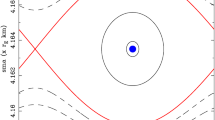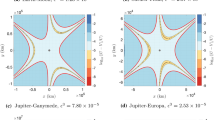Abstract
Long term evolution of the Molniya satellites are investigated by means of historical data analysis, theoretical analysis and numerical integration. Both the mean motion resonance problem and the critical inclination problem are studied. The period and the amplitude of the semi-major axis for each satellite are obtained analytically and compared with the observational data. In addition, the reason of the observed sudden changes in the center and the amplitude of the oscillating semi-major axes is determined as the effect of the atmosphere drag. For the long period perigee motion, the dominant perturbations come from the luni-solar gravity. A two-degree-of freedom system is established by adding the two periodic terms of the neighbor resonances to the Hamiltonian of the classical single resonance model. In theory, the resulting resonance overlap model is responsible for the chaotic layer between the libration region and the circulation region. In practice, it is applied to explain the quick decay of the earliest Molniya satellites and to study the satellites that still orbiting the Earth at present.









Similar content being viewed by others
References
Breiter, S.: Lunisolar resonances revisited. Celest. Mech. Dyn. Astron. 81(1–2), 81–91 (2001)
Chirikov, B.V.: A universal instability of many-dimensional oscillator systems. Phys. Rep. 52(5), 263–379 (1979)
Cook, G.E.: Luni-solar perturbations of the orbit of an Earth satellite. Geophys. J. 6(3), 271–291 (1962)
Delhaise, F., Henrard, J.: The problem of critical inclination combined with a resonance in mean motion in artificial satellite theory. Celest. Mech. Dyn. Astron. 55(3), 261–280 (1993)
Delhaise, F., Morbidelli, A.: Luni-solar effects of geosynchronous orbits at the critical inclination. Celest. Mech. Dyn. Astron. 57(1–2), 155–173 (1993)
Ely, T.A., Howell, K.C.: Long term evolution of artificial satellite orbits due to resonant tesseral harmonics. J. Astronaut. Sci. 44(2), 167–190 (1996)
Ely, T.A., Howell, K.C.: Dynamics of artificial satellite orbits with tesseral resonances including the effects of luni- solar perturbations. Dyn. Stab. Syst. 12(4), 243–269 (1997)
Giacaglia, G.E.O.: Lunar perturbations of artificial satellites of the Earth. Celest. Mech. 9(2), 239–267 (1974)
Hough, M.E.: Orbits near critical inclination, including lunisolar perturbations. Celest. Mech. 13(2), 111–136 (1981)
Jupp, A.H.: The critical inclination problem with small eccentricity I: General theory. Celest. Mech. 21(3), 361–393 (1980)
Lane, M.T.: On analytic modeling of lunar perturbations of artificial satellites of the Earth. Celest. Mech. Dyn. Astron. 46(4), 287–305 (1989)
Lichtenberg, A.J., Lieberman, M.A.: Regular and Chaotic Dynamics, 2nd edn. Springer, New York (1992)
Stefanelli, L., Metris, G.: Solar gravitational perturbations on the dynamics of MEO: increase of the eccentricity due to resonances. Adv. Space Res. 55(7), 1855–1867 (2015)
Sun, R.-Y., Zhao, C.-Y., Zhang, M.-J., Hou, Y.-G.: Dynamical evolution of high area-to-mass ratio objects in Molniya orbits. Adv. Space Res. 51(11), 2136–2144 (2013)
Xiong, J.-N., Wu, L.-D., Zhao, C.-Y.: Orbit lifetime research of GTO space debris. Acta Astron. Sin. 49(3), 297–305 (2008)
Zhu, T.-L., Zhao, C.-Y., Zhang, M.-J.: Long term evolution of Molniya orbit under the effect of Earth’s non-spherical gravitational perturbation. Adv. Space Res. 54(2), 197–208 (2014)
Acknowledgements
This research was supported by the National Science Fund for Distinguished Young Scientists of China (Grant no. 11125315). The authors would like to thank the anonymous reviewer for the valuable comments that help to improve the manuscript.
Author information
Authors and Affiliations
Corresponding author
Rights and permissions
About this article
Cite this article
Zhu, TL., Zhao, CY., Wang, HB. et al. Analysis on the long term orbital evolution of Molniya satellites. Astrophys Space Sci 357, 126 (2015). https://doi.org/10.1007/s10509-015-2355-y
Received:
Accepted:
Published:
DOI: https://doi.org/10.1007/s10509-015-2355-y




